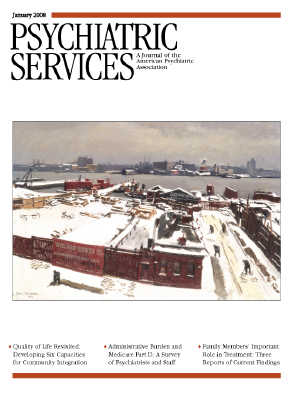Assertive Community Treatment for Older Adults
Adults age 60 and older are the fastest-growing segment of the U.S. population. An estimated 20% experience specific psychiatric disorders, but of those only half receive treatment from any health care provider. Few older adults receive specialty mental health services.
In 2001 Telecare Corporation (a multistate mental health care organization) was asked by the Los Angeles County Department of Mental Health to provide a full-fidelity program of assertive community treatment for this underserved population. Three key adaptations were made: increasing knowledge about the complex interplay between physical and mental health, learning about community resources available specifically for older adults, and taking care not to let ageism affect services.
To be eligible for enrollment, individuals must meet six criteria: be age 50 or above, have a severe mental illness, have significant functional impairments, have continuous high-service needs, be willing and able to reside in a community setting within the geographic area served by the program, and be willing to accept services.
Telecare's ACT 7 program has a multidisciplinary team that serves as the primary provider of services. The team is led by a licensed clinical social worker and includes three nurses, three master's-level social workers, two half-time psychiatrists, a personal service coordinator (who is in recovery from mental illness), a substance abuse specialist, and an employment specialist. The staff-to-member ratio is 1:10 at full enrollment of 100 individuals.
The program is staffed Monday through Friday from 8:30 a.m. to 8:30 p.m. Weekend and holiday hours are 8:30 a.m. to 5:00 p.m. After hours, a team member is available by phone and will go out into the community to see a client when necessary.
The team meets every morning to discuss the individuals seen the day before and any crises that have occurred and to plan for the coming day. There are no assigned caseloads; the entire team is available to work with each individual on the basis of his or her needs.
Services are directed by a personal service plan that the team writes together with the client. All plans contain growth rather than maintenance goals. Services are founded on a psychosocial rehabilitation philosophy, which focuses on recovery and strengths rather than on illness and disability. Services are highly individualized; the content, amount, timing, and types of service vary across individuals and time. The contractual commitment is to have an average of three contacts per week by the team, although multiple contacts per day can be provided. Over 95% of face-to-face services are provided in the community, including visits by the psychiatrists.
Fifty-three individuals were admitted during the first year of the program, with 42 completing a full year's worth of service. The average age at admission was 59.95 years (range= 50.25–75.83). A majority (57%) were female. Sixty-seven percent were Caucasian, 19% were African American, and 14% were Latino or Hispanic. A majority had a diagnosis of schizophrenia (57%) or schizoaffective disorder (36%). Seven percent had a diagnosis of bipolar disorder.
Nearly three-quarters (74%) of the individuals were admitted directly from institutional care. In the year before enrollment, the 42 individuals spent a total of 10,771 days in a geropsychiatric skilled nursing facility, 483 days in acute psychiatric inpatient care, 631 days in subacute psychiatric care, 365 days in a state hospital, and 16 days in a jail inpatient psychiatric unit. This is a total of 12,266 days (mean±SD=292.05± 58.12) of institutional care. None of the 42 individuals received outpatient mental health services.
On average, in their first year in the program, individuals received 201.10 contacts (184.70 hours). This represents a mean of 3.9 contacts (3.5 hours) per person per week. Most contacts were for rehabilitation services, followed by medication support, case management, and crisis intervention.
Seventeen percent of individuals were hospitalized in acute care psychiatric facilities. Six people were hospitalized once, and one person was hospitalized three times. The total number of days of hospitalization was 86 (mean length of stay of 9.55 days per episode; range=2–20 days). These numbers are skewed by one person who was hospitalized for 39 days.
The combined cost of community and inpatient services was $1,319,115 ($31,408±$13,194 per person). The total cost for mental health services received the year before enrollment was $3,285,663 ($78,229±$33,773 per person).
As the population ages, the need for effective and appropriate mental health services for older adults will only continue to grow. The experiences of the Telecare ACT 7 program suggest that assertive community treatment is a promising model to meet the needs of older adults with severe mental illnesses.



